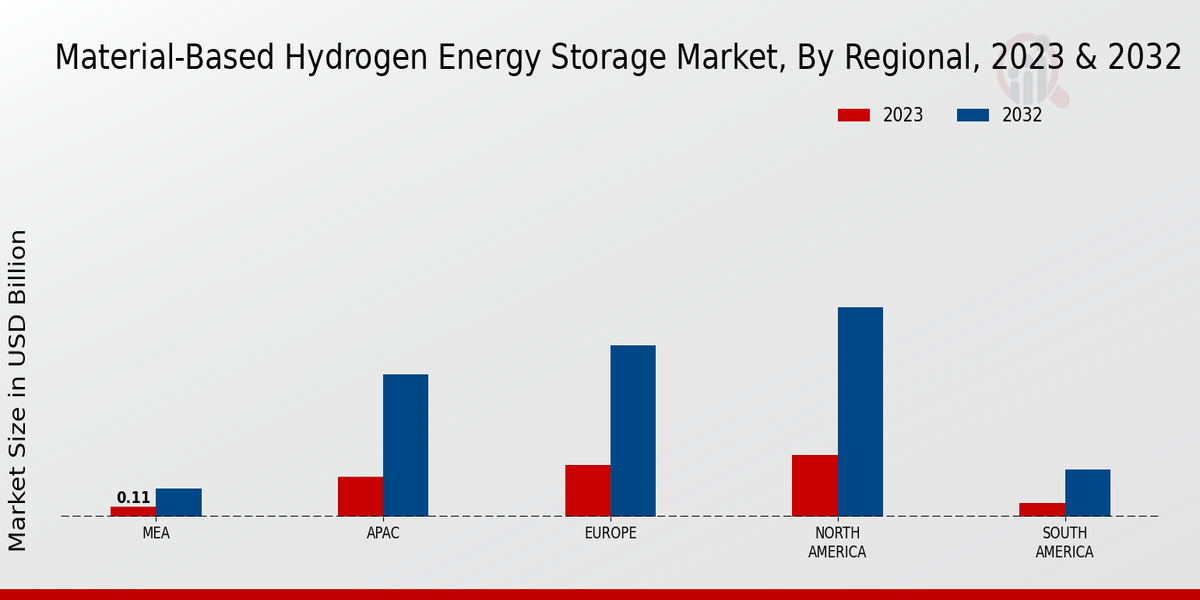Diverse Applications Across Industries
The versatility of hydrogen storage technologies is a significant driver for the Material-Based Hydrogen Energy Storage Market. Hydrogen can be utilized across various sectors, including transportation, power generation, and industrial processes. For example, fuel cell vehicles are increasingly being adopted, necessitating efficient hydrogen storage solutions. Additionally, industries such as steel manufacturing are exploring hydrogen as a cleaner alternative to traditional fossil fuels. This broad applicability suggests that the Material-Based Hydrogen Energy Storage Market could experience robust growth as different sectors seek to integrate hydrogen into their operations. The potential for diverse applications may attract further investment and innovation in hydrogen storage technologies.
Supportive Regulatory Frameworks and Policies
Supportive regulatory frameworks are crucial for the advancement of the Material-Based Hydrogen Energy Storage Market. Governments worldwide are implementing policies that promote the use of hydrogen as a clean energy source. Incentives such as tax credits, grants, and subsidies for hydrogen projects are becoming more common, encouraging research and development in hydrogen storage technologies. For instance, recent policy initiatives in several countries aim to establish hydrogen as a key component of their energy strategies. This regulatory support is likely to foster a conducive environment for the Material-Based Hydrogen Energy Storage Market, facilitating growth and encouraging stakeholders to invest in innovative hydrogen storage solutions.
Technological Innovations in Hydrogen Storage
Technological advancements in hydrogen storage materials are propelling the Material-Based Hydrogen Energy Storage Market forward. Innovations such as metal hydrides, chemical hydrides, and advanced carbon-based materials are enhancing storage capacity and efficiency. For instance, recent developments indicate that certain metal hydrides can achieve hydrogen storage densities exceeding 6 wt%, which is crucial for practical applications. Furthermore, the integration of nanotechnology in material science is likely to improve the kinetics of hydrogen absorption and desorption, making these materials more viable for commercial use. As the demand for efficient energy storage solutions rises, these technological innovations are expected to play a pivotal role in shaping the future of the Material-Based Hydrogen Energy Storage Market.
Increasing Investment in Hydrogen Infrastructure
Investment in hydrogen infrastructure is a key driver for the Material-Based Hydrogen Energy Storage Market. Governments and private entities are channeling funds into the development of hydrogen production, storage, and distribution systems. For example, recent reports suggest that investments in hydrogen infrastructure could reach USD 300 billion by 2030, reflecting a growing recognition of hydrogen as a clean energy carrier. This influx of capital is likely to enhance the availability and accessibility of hydrogen storage solutions, thereby stimulating market growth. As infrastructure improves, the Material-Based Hydrogen Energy Storage Market is poised to benefit from increased adoption and integration of hydrogen technologies across various sectors.
Rising Environmental Concerns and Sustainability Goals
Rising environmental concerns are driving the Material-Based Hydrogen Energy Storage Market as stakeholders seek sustainable energy solutions. The urgency to reduce carbon emissions and combat climate change has led to a shift towards cleaner energy sources, including hydrogen. Many countries are setting ambitious sustainability goals, with hydrogen playing a crucial role in achieving these targets. For instance, the European Union aims to produce 10 million tons of renewable hydrogen by 2030, which underscores the potential of hydrogen storage technologies. This growing emphasis on sustainability is likely to create a favorable environment for the Material-Based Hydrogen Energy Storage Market, as businesses and governments prioritize investments in eco-friendly energy solutions.


















Leave a Comment